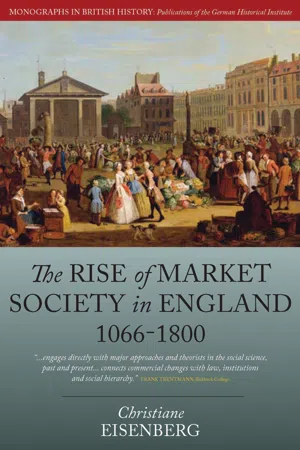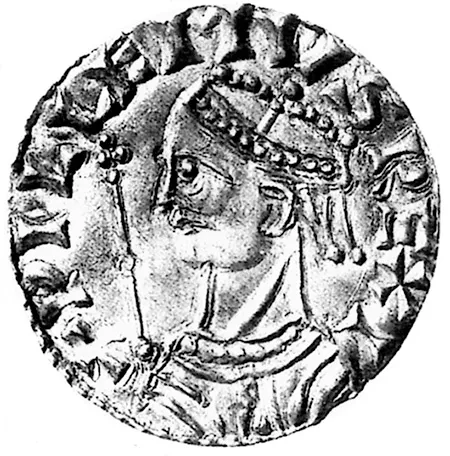![]()
Chapter 1
MEDIEVAL FOUNDATIONS OF MARKET EXCHANGE
As late as the 1970s and 1980s, the dominant opinion in economic history was still that England’s early modern upturn had been preceded by a stagnating medieval economy. Significant social changes had not taken place, productivity had been low, and most of the rural population had laboured for their own subsistence.1 These assumptions have proven to be unfounded; rather, during the High Middle Ages, the English economy experienced a considerable upswing. In the area of agriculture, efforts were made for the first time to coordinate farming and livestock breeding, regional specialization developed, and the population grew. In a parallel development, the number of both cities and their residents rose, as did the price of labour, land and capital. Against this background, the amount of money in circulation increased, and a rudimentary system of credit developed.2 The trans-European plague epidemic of 1348/49 interrupted this development only temporarily.
One can observe similar processes at this time on the European continent. However, it is clear that the demographic and economic crises caused by the plague in the mid-fourteenth century were overcome more quickly and easily in England than in the north, south or west of Europe (with the exception of the Netherlands).3 In England, the plague-related labour shortage led to permanent wage increases despite the fact that the collapse of the system of bonded labour towards the end of the fourteenth century added a great number of new workers to the workforce. A further indication that the crisis was successfully overcome was that landowners gave some of their former bondsmen posts and entrusted them with administrative duties, with the effect that knowledge of trade, laws and management methods were further spread.4 The sustainability of the postpestilential upswing is attested to not least by the observation that while extraction methods remained the same, coal production steadily increased into the sixteenth century due solely to the fact the additional demand for it existed.5
These findings give us occasion to suspect that in England, communication structures and behavioural routines were in place that enabled contemporaries to take advantage of economic changes flexibly and productively. Two observations underline this assumption and simultaneously point to possible explanations.
For one, with the exception of London, English cities – in comparison with southern Germany and northern Italy, for example – had relatively small populations of about five thousand inhabitants, a particularity that can be explained not only in terms of the relative unimportance of foreign trade at that time, but also and above all of the high level of market integration locally. Unlike in Germany, where cities were isolated ‘islands’ amidst the surrounding countryside that ‘[raised] themselves above the general barter economy’, to quote the historian Georg Brodnitz from a 1914 publication, English cities were market locations engaged in brisk trade with the equally market-oriented rural areas. If they wanted to survive as ‘centres of economic exchange’, they had to respond to impulses from the surrounding countryside.6
For another, one could argue that already with the Norman Invasion in the eleventh century, a specific form of feudalism developed in England that was more encouraging of the emergence of market-supported (and therefore flexible) trade than were the comparable governance and economic structures on the European continent. In the following, this English type of feudalism shall be discussed at greater length, since it is safe to assume that it created the preconditions for the formation and establishment of processes of commercialization.7
Both particularities – the size of English cities and their feudal governance structures – were interrelated, and both developed in the wake of the political upheavals triggered by the Norman Invasion of 1066.
Institutions and Law
After his victory at the Battle of Hastings, William the Conqueror, Duke of Normandy, not only made England into a colony of the West Frankish Kingdom, but also into a uniformly occupied territory. In contrast to comparable invasions by the Normans elsewhere in Europe, for example in Sicily or the Kiev region, there was no cooperation with the old ruling elites. Rather, in subsequent battles of conquest, William liquidated or drove out nearly all of the four thousand to five thousand members of the Anglo-Saxon aristocracy. He divided the conquered territory up among 189 of his followers, whom he elevated to the status of lords and upon whom he imposed tax duties and military service obligations.8
These feudal obligations might in themselves be an extension of the Anglo-Saxon tradition; the experts are not of one mind on this point. The centralist administration of the new state, which was tailored to the King, can, however, be regarded as an innovation in terms of governance, even if on the local level, the old Anglo-Saxon administrative organization into ‘shires’ and ‘hundreds’ was preserved.9 In all of the shires, William and his successors set up courts of law. As local office holders, the aldermen represented the King’s interests, while the sheriffs and bailiffs served as the forces of order. The King’s Court, established in the early thirteenth century as the central court of law, was responsible for major cases. A central tax authority, the Exchequer, received the account statements and earnings of the King’s agents from all corners of the empire and audited them. In the Chancery, official state documents were issued and stored. Such writs documented, among other things, the modalities of tax collection and the changes in the distribution of land ownership.10 Cities had a subordinate status within this centralized system. Neither military nor political competencies were granted to them by the King or his successors.11
The new state was stable: the emergence of dynasties, with the associated subdivision of territories into ever-smaller sovereignties observable elsewhere in Europe, did not take place here. This was surely due in part to England’s literal insularity, which offered a certain measure of protection from invasion, as well as to the modest size of the territory, which made internal integration easier. Thus it was possible for the King and his travelling judges to regularly visit all parts of the country, despite the difficult conditions of travel in the Middle Ages.12 However, there were also other small dominions in Europe, e.g., Scotland and Sicily, that did not achieve as high a degree of integration as England. This speaks in favour of regarding the early development of a unitary state and the associated monopoly of power by the King as particular stabilising factors.
Figure 1.1. Coin of William of Conqueror, 1068.
Within the framework of the present study, this thoroughgoing centralism is relevant primarily because it gave the country a considerable push towards commercialization. Of foremost significance is the side effect that it resulted in the creation a contiguous economic and juridical area without any significant internal tariffs13 and that free persons could, with the aid of royal justice and of professional legal experts, take action against swindlers, bankrupts, bad debtors and contract breakers. By 1362, they could even do so in the vernacular tongue, as English became the official language of justice in that year.14 Furthermore, in a continuation of Anglo-Saxon conventions, unitary weights and measures as well as a single currency were used. The Normans gradually replaced the old penny coins with ones of sterling silver, and thenceforth value was measured in pounds sterling.15
Secondly, William the Conqueror and his successors introduced a reorganization of the market for agricultural land. As this market calls for a state framework, one could presumably even say that they ‘introduced’ this type of market. The lords were permitted to sell the use rights to the land allotted to them to anyone they chose, or to purchase or lease land, so long as no contiguous territories resulted that might have called into question the direct dominion of the King. As is documented in the famous Domesday Book (1086), which William commissioned to gain and maintain an overview of the distribution of property and to avoid a concentration of acreage in the hands of individuals, the number of landholders had grown to several thousand within twenty years of the Conquest.16 When the King’s Court placed the purchasers of land, the so-called freemen, under its jurisdiction in the course of the thirteenth century so that they could emancipate themselves from the lords by means of royal writs and then work the land as they pleased, the number of market participants increased once again.17
Thirdly, the institutionalization of a land market gave impetus to the capital market. Land could henceforth stand as a security, and in turn loans were entered into to purchase land. Furthermore, feudal dues and leaseholds were generally rendered in cash, and for this, as well, it was often necessary to borrow money.18
Fourthly, the Crown monopoly on foreign currency trading – yet another aspect of royal centralism – favoured the early and universal establishment of a credit system. That the Royal Exchanger and his functionaries rigorously confiscated coins in foreign currencies to take them to the Tower Mint to be melted down and reminted as sterling coins contributed significantly to the English peculiarity that neither deposit banks nor a system of monetary trading, which elsewhere in Europe emerged out of currency trading in the Middle Ages, were founded. Instead, in England – and at this early point in time only there – bills of exchange, bonds and other commercial papers were acknowledged in payment transactions.19 While such papers did carry a certain amount of risk, they had the advantage that they were transferable and could be freely reproduced independently of the right of coinage. This increased the range and speed of capital circulation, reduced the loss of value through currency exchange and averted the necessity of the risk-laden transport of coins. Furthermore, it helped circumvent the church ban on interest, as bills of exchange allowed the interest on borrowings to appear as a fee or to be hidden in the exchange rate. Above all, however, in view of the notorious shortage of coins in the Middle Ages, the economy of bills of exchange increased the number of market actors and the volume of transactions. As Matthew Rowlinson notes, it also stimulated professional trading because it ‘sets a price not only on the abstractions of time and place, but also on that of money itself’.20
That a society of owners and acquisition emerged out of the system of ‘distributive feudalism’ (Verteilungsfeudalismus, Günther Lottes) was an effect of, rather than the motivation behind, the state-building efforts of William the Conqueror and his successors. What was of primary concern to these kings was the securing of their rule and the assurance of the cooperation of the lords that this demanded.21 The former could never, however, be entirely certain of the latter’s loyalty, and this led to further measures of enforcing their sovereignty, which had commercial side effects.
The financial side of rule was comparatively unproblematic. It was possible where necessary to enforce the collection of agricultural dues and taxes directly from all tax-paying subjects so as to reduce the financial dependence of the King upon the lords.22 With respect to military service, however, such (precautionary) measures were not so easy to implement, as the troops led by the lords could abandon the battlefield at any time. The solution to the problem consisted for the King in replacing military service requirements with shield money (also known as scutage) and, in times of...


